- Clone
- Poly5166 (See other available formats)
- Regulatory Status
- RUO
- Other Names
- Interleukin-17F, IL-17F
- Isotype
- Goat Polyclonal Ig
- Ave. Rating
- Submit a Review
- Product Citations
- publications
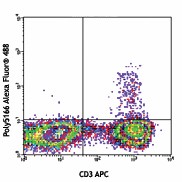
-

PMA + ionomycin-stimulated (6 hours in the presence of monensin) human peripheral blood lymphocytes surface stained with CD3 APC, fixed and permeabilized and stained with IL-17F (clone Poly5166) Alexa Fluor® 488 (top) or blocked by pre-incubation with purified IL-17F (Poly5166) (bottom). -

| Cat # | Size | Price | Quantity Check Availability | Save | ||
|---|---|---|---|---|---|---|
| 516603 | 25 tests | 147 CHF | ||||
| 516604 | 100 tests | 347 CHF | ||||
IL-17F is part of the IL-17 cytokine family which consists of at least seven structurally related proteins (IL-17A, B, C, D, E, F, and A/F). IL-17F homodimer adopts a cysteine knot motif formed through the interactions of four cysteines, one of which is responsible for inter-chain bonding. IL-17F is most closely related to IL-17A, sharing 50% amino acid sequence homology. It is expressed by Th17 cells, along with IL-17A homodimer and IL-17A/F heterodimer. IL-17F has been shown to inhibit endothelial cell angiogenesis and induce increased production of IL-2, TGF-β, and MCP-1, playing a critical role in the regulation of inflammatory reactions and in a variety of auto-immune diseases.
The IL-17A/F heterodimer consists of the monomeric units of IL-17A and IL-17F. It is a naturally expressed and biologically active molecule. While much has been studied about IL-17A and IL-17F, it is still unclear how each distinctively induces the inflammatory response, and what role IL-17A/F also plays in it. It is known that all three cytokines are produced in different amounts, and each has different degrees of pro-inflammatory effects. All seem to interact with the IL-17RA/IL-17RC receptor complex, and signal via the NF-κB pathway to induce secretion of inflammatory cytokines and recruit granulocytes.
BioLegend's purified Poly5166 antibody is IL-17F specific and can be paired with biotinylated Poly5166 to recognize IL-17F or with biotinylated anti-human IL-17A clone BL23 to recognize the IL-17A/F heterodimer.
Product Details
- Verified Reactivity
- Human
- Antibody Type
- Polyclonal
- Host Species
- Goat
- Immunogen
- Recombinant protein
- Formulation
- Phosphate-buffered solution, pH 7.2, containing 0.09% sodium azide and BSA (origin USA)
- Preparation
- The antibody was purified by affinity chromatography and conjugated with Alexa Fluor® 488 under optimal conditions.
- Concentration
- Lot-specific (to obtain lot-specific concentration and expiration, please enter the lot number in our Certificate of Analysis online tool.)
- Storage & Handling
- The antibody solution should be stored undiluted between 2°C and 8°C, and protected from prolonged exposure to light. Do not freeze.
- Application
-
FC - Quality tested
- Recommended Usage
-
Each lot of this antibody is quality control tested by immunofluorescent staining with flow cytometric analysis. For flow cytometric staining, the suggested use of this reagent is 5 µl per million cells in 100 µl staining volume or 5 µl per 100 µl of whole blood.
* Alexa Fluor® 488 has a maximum emission of 519 nm when it is excited at 488 nm.
Alexa Fluor® and Pacific Blue™ are trademarks of Life Technologies Corporation.
View full statement regarding label licenses - Excitation Laser
-
Blue Laser (488 nm)
- Application Notes
-
The pure Poly5166 (Cat. No. 516601) antibody is useful as the capture antibody in a sandwich ELISA assay. Poly5166 can be used as a poly-poly pair with biotinylated Poly5166 to recognize human IL-17F, or it can be used as a poly-mono pair with biotinylated BL23 (Cat. No. 512705) to recognize the human IL-17A/F heterodimer (Cat. No. 580609).
- Product Citations
-
- RRID
-
AB_10720816 (BioLegend Cat. No. 516603)
AB_10720816 (BioLegend Cat. No. 516604)
Antigen Details
- Structure
- Homodimer
- Distribution
-
T cells, Th17 cells, memory CD4 T cells, gamma delta T cells, and epithelial cells, activated human mast cells, and basophils
- Function
- IL-17F induces various cytokines, chemokines, and adhesion molecules, including IL-6, IL-8, CXCL1, CXCL5, transforming growth factor-b (TGF-b), CCL2, G-CSF, granulocyte macrophage-colony forming factor (GM-CSF) and intracellular adhesion molecule-1 (ICAM-1), in airway epithelial cells, vein endothelial cells, and fibroblasts.
- Interaction
- IL-17F might act primarily on parenchymal cells such as fibroblasts, epithelial cells, and endothelial cells.
- Ligand/Receptor
- IL-17F utilizes IL-17RA and IL-17RC
- Cell Type
- Basophils, Epithelial cells, Mast cells, T cells, Th17
- Biology Area
- Cell Biology, Immunology, Neuroinflammation, Neuroscience
- Molecular Family
- Cytokines/Chemokines
- Antigen References
-
- Starnes T, et al. 2001. J. Immunol. 167:4137.
- Kawaguchi M, et al. 2001. J. Immunol. 167:4430.
- Hizawa N, et al. 2006. Clin Experimental Allergy 36:1109.
- Seiderer J, et al. 2008. Inflamm Bowel Dis. 14:437.
- Wu X, et al. 2010 Int J Cancer 127:86.
- Gene ID
- 112744 View all products for this Gene ID
- UniProt
- View information about IL-17F on UniProt.org
Related FAQs
Other Formats
View All IL-17F Reagents Request Custom Conjugation| Description | Clone | Applications |
|---|---|---|
| Alexa Fluor® 488 anti-human IL-17F | Poly5166 | FC |
| Purified anti-human IL-17F | Poly5166 | ELISA Capture |
Customers Also Purchased
Compare Data Across All Formats
This data display is provided for general comparisons between formats.
Your actual data may vary due to variations in samples, target cells, instruments and their settings, staining conditions, and other factors.
If you need assistance with selecting the best format contact our expert technical support team.
-
Alexa Fluor® 488 anti-human IL-17F
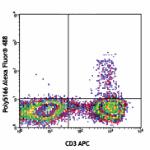
PMA + ionomycin-stimulated (6 hours in the presence of monen... 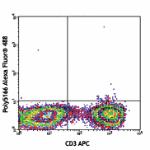
-
Purified anti-human IL-17F
 Login / Register
Login / Register 











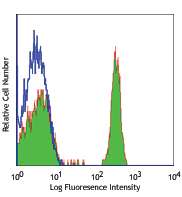
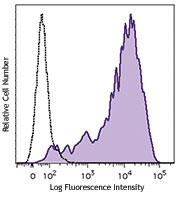

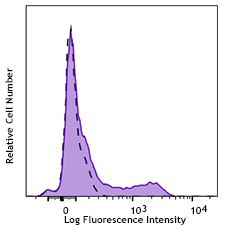
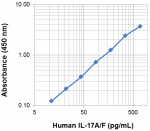



Follow Us